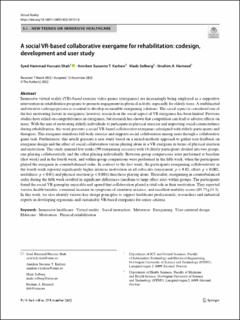| dc.contributor.author | Shah, Syed Hammad Hussain | |
| dc.contributor.author | Karlsen, Anniken Th | |
| dc.contributor.author | Solberg, Mads | |
| dc.contributor.author | Hameed, Ibrahim A. | |
| dc.date.accessioned | 2023-02-27T12:56:02Z | |
| dc.date.available | 2023-02-27T12:56:02Z | |
| dc.date.created | 2022-11-16T23:57:43Z | |
| dc.date.issued | 2022 | |
| dc.identifier.issn | 1359-4338 | |
| dc.identifier.uri | https://hdl.handle.net/11250/3054284 | |
| dc.description.abstract | Immersive virtual reality (VR)-based exercise video games (exergames) are increasingly being employed as a supportive intervention in rehabilitation programs to promote engagement in physical activity, especially for elderly users. A multifaceted and iterative codesign process is essential to develop sustainable exergaming solutions. The social aspect is considered one of the key motivating factors in exergames; however, research on the social aspect of VR exergames has been limited. Previous studies have relied on competitiveness in exergames, but research has shown that competition can lead to adverse effects on users. With the aim of motivating elderly individuals to participate in physical exercise and improving social connectedness during rehabilitation, this work presents a social VR-based collaborative exergame codesigned with elderly participants and therapists. This exergame stimulates full-body exercise and supports social collaboration among users through a collaborative game task. Furthermore, this article presents a user study based on a mixed-methods approach to gather user feedback on exergame design and the effect of social collaboration versus playing alone in a VR exergame in terms of physical exertion and motivation. This study spanned five weeks (99 exergaming sessions) with 14 elderly participants divided into two groups, one playing collaboratively and the other playing individually. Between-group comparisons were performed at baseline (first week) and in the fourth week, and within-group comparisons were performed in the fifth week, when the participants played the exergame in counterbalanced order. In contrast to the first week, the participants exergaming collaboratively in the fourth week reported significantly higher intrinsic motivation on all subscales (enjoyment: p < 0.02, effort: p < 0.002, usefulness: p < 0.01) and physical exertion (p < 0.001) than those playing alone. Thereafter, exergaming in counterbalanced order during the fifth week resulted in significant differences (medium to large effect size) within groups. The participants found the social VR gameplay enjoyable and agreed that collaboration played a vital role in their motivation. They reported various health benefits, a minimal increase in symptoms of simulator sickness, and excellent usability scores (83.75±13.3). In this work, we also identify various key design principles to support healthcare professionals, researchers and industrial experts in developing ergonomic and sustainable VR-based exergames for senior citizens. | en_US |
| dc.language.iso | eng | en_US |
| dc.publisher | Springer | en_US |
| dc.relation.uri | https://link.springer.com/article/10.1007/s10055-022-00721-8 | |
| dc.rights | Navngivelse 4.0 Internasjonal | * |
| dc.rights.uri | http://creativecommons.org/licenses/by/4.0/deed.no | * |
| dc.title | A social VR-based collaborative exergame for rehabilitation: codesign, development and user study | en_US |
| dc.title.alternative | A social VR-based collaborative exergame for rehabilitation: codesign, development and user study | en_US |
| dc.type | Peer reviewed | en_US |
| dc.type | Journal article | en_US |
| dc.description.version | publishedVersion | en_US |
| dc.source.journal | Virtual Reality | en_US |
| dc.identifier.doi | 10.1007/s10055-022-00721-8 | |
| dc.identifier.cristin | 2075216 | |
| cristin.ispublished | true | |
| cristin.fulltext | original | |
| cristin.fulltext | original | |
| cristin.qualitycode | 1 | |

